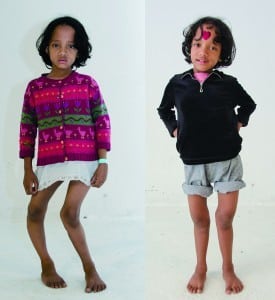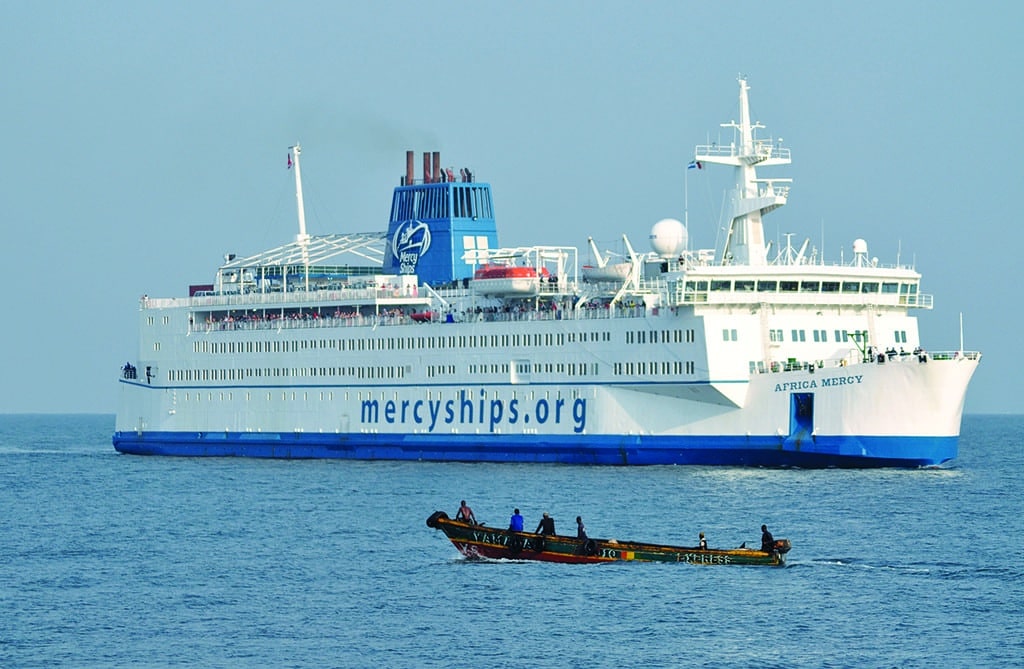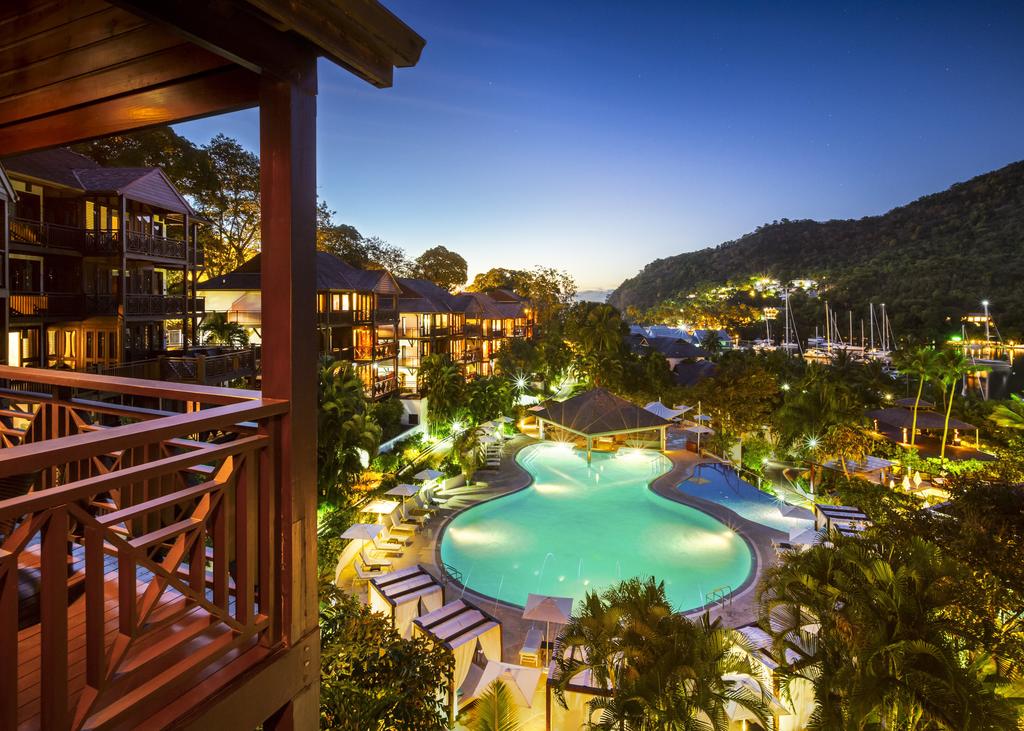Jon Fadely is a professional mariner working with the global charity, Mercy Ships. A licensed deep-sea captain, he has served as Master on four of the five Mercy Ships, from 1992 until now. Jon, his wife Angie and their three children lived for 11 years on board two different ships, travelling to many parts of the world with volunteer crewmembers and bringing hope and healing to the poor. Their children now grown, Jon and Angie live in Lindale, Texas, where they serve full time at the International Operations Center of the organization.
SB: What attracted you to work for Mercy Ships?
JF: Firstly, it was that I could use my professional maritime skills to help serve those in need around the world. Secondly, that my family could join me; my wife could also serve in a professional capacity (HR management) and our children could live with us on board and continue their education in an accredited school.
SB: How did you find out about the organization?
JF: My brother worked with the parent organization in the 1980s and advised us of the upcoming visit of the Mercy Ship Anastasis to Houston, where we lived and worked at the time. He also volunteered us to help the ship’s advance team with the port arrangements! Then, once the ship arrived, we visited the crew on board and heard more about their work.
SB: Please succinctly describe the work and goal of the organization?
Mercy Ships follows the 2,000-year-old model of Jesus, bringing hope and healing to the world’s forgotten poor. We use ocean-going hospital ships crewed by international volunteer professionals and supported by offices in 16 nations, to deliver a variety of health care services to the people of developing nations through programs, which include life-changing surgeries, vocational training and education.
SB: How long have you been with the organization? In what corners of the world have you traveled to?
Twenty-three years. We joined Mercy Ships on April 1st, 1992 as a family of five, and have traveled to Central and South America, including one trip up the Amazon River; throughout the Caribbean; into the Great Lakes, twice; along the East, Gulf and West coasts of North America (both U.S. and Canadian ports); around the northern Pacific Rim including stops in Alaska, Russia, China, Korea, the Philippines, Guam and Hawaii; several countries in Europe; Great Britain; and several countries in West, Central and Southern Africa, most recently to the island of Madagascar.
SB: What is your position today? Have you always held the same position?
I “wear three hats” in Mercy Ships at the moment: Quality Management Systems Developer, Child Safety Manager and (part-time) Maritime Safety Instructor. I also keep my “Captain’s hat” ready (including my deep-sea unlimited license) in case the organization needs a relief skipper.
I first served in Mercy Ships in my capacity as a licensed maritime professional: as Chief Officer, then Captain of the smaller ships in the fleet; then eventually as Captain on each of our larger ships. After moving ashore to work in our main office in 2003, I have served as Safety Manager and also Director of Marine Operations.
In general, I provide a range of internal consulting services to the managers and senior leaders as we work together to make the organization more effective and more efficient. My maritime training and experience have given me an appreciation for managing complex systems and coordinating the efforts of a wide range of talents and temperaments to achieve a common goal.

SB: Can you tell us about one your favorite stories with your position and the organization?
JF: In 1994, on the first mission voyage of the Caribbean Mercy, we were sailing from Florida to the Dominican Republic along the north coast of Cuba, when I was called to bridge; the lookout had reported a yellow flag waving off the starboard beam. As we watched, we could barely see the hull of a small motorboat cresting the waves then disappearing back in the trough. We altered course to investigate and as we drew alongside the boat, we learned there were over 20 Cubans on board, including women and children; the boat was out of gas; and they had been out at sea for more than two days. We brought them on board to assess their condition and provide the care they needed: several were dehydrated and one woman was fading in and out of consciousness.
One of the Cubans said he was a doctor, and that they were attempting to get to Miami in order to emigrate to the U.S. He said the hardest thing for them had been drifting at sea with no power, watching ship after ship sail on by, but none stopping to help. I was aware that the Coast Guard had active patrols in the Windward Passage, and so contacted them to request a transfer. They agreed and we established a rendezvous, which we reached the next day. All of the Cubans survived their ordeal at sea, and were safely transferred to the U.S. Coast Guard. I’m not sure what happened to them after that, but I believe they may have been taken to Guantanamo Bay. Before he left, the Cuban doctor gave me his stethoscope as a sign of their thanks for being rescued.
SB: What are you most proud of accomplishing in your position?
JF: I’ve been privileged to be involved in many special efforts and projects throughout my years with Mercy Ships, but one achievement, which helped shape me in my course with this organization was the commissioning and maiden voyage of the Caribbean Mercy.
In the spring of 1994, in St. Petersburg, Florida, my wife and I heard, along with the rest of the crew of our Mercy Ship, the Good Samaritan, that we would be transferring to a new ship, which the organization was purchasing. The Good Samaritan, in turn, would be delivered to our colleagues in New Zealand, who would rename it the Island Mercy and carry on an effective medical program in the South Sea Islands of the Pacific. The catch? The “new” ship, to be renamed the Caribbean Mercy, was 42 years old, laid up in Norway, and had only ever been classed and equipped for coastal ferry service. We needed to send a commissioning team over to Norway to work with surveyors and naval architects to re-classify the ship and then sail it across the Atlantic Ocean, to Florida.
I arrived on board in late April, and caught up with our German Chief Engineer. “Edgar,” I asked, “How soon will you be ready to run these engines?” “As soon as I figure out how to read Norwegian!” he replied with a wry smile. We recruited a team of local translators to provide us English versions of all of the operating and maintenance manuals, addressed a myriad of other technical and regulatory details, and sailed from Norway on May 24th, the ship’s cargo holds filled with construction and medical supplies from our generous Norwegian friends. After stopping in Rotterdam, the Azores and the Bahamas for fuel, we arrived in Tampa on June 13th, sailing in under the Sunshine Skyway Bridge with its two pylons lit up like guardian angels, the eastern sky ahead growing lighter with the dawn. One mission accomplished, many more missions to go.
SB: What do you love most about what you do?
JF: The people I work with in Mercy Ships, from the office staff to the crew members of the ships, are some of the most dedicated, selfless, hard-working people I’ve ever known. Sure, we have our problems, our misunderstandings, our hurt feelings and bent egos. But over all and through all and in all runs a deep, personal and profound commitment to the mission of the organization: to bring hope and healing to the world’s forgotten poor.
SB: Did you grow up with a love for the ocean/water? Did you enjoy boating/fishing as a child? Do/did you own a boat, if so what is the name and make? What kind of fishing do you enjoy?
JF: I grew up in Liberia, West Africa, for several years living right on the beach in Monrovia. Sand and salt water evoke “home” for me, even today. At a young age, I learned to snorkel and bodysurf; I read all I could find about Jacques Cousteau and the Calypso. Robin Lee Graham and his single-handed voyage around the world on the Dove also inspired me. In college I studied marine sciences and navigation at Texas A&M University at Galveston, then worked with Western Geophysical in their seismic research vessels upon graduation.
I’ve never owned a boat myself, but always enjoy getting out on the water, whether sailing a friend’s dinghy on Lake Minnetonka, or cruising on a catamaran from St Maarten to Saint Barthelemy, or navigating a Mercy Ship to Madagascar. I’ve enjoyed deep-sea fishing for sailfish and marlin off Mazatlan; I’ve attempted fly-fishing for trout in Missouri (the trout won); but thanks to my father and grandfather, my “go-to” is spin casting for bass and other freshwater lake fish.
For more information about volunteering for a maritime or other position with Mercy Ships go to mercyships.org
ABOUT MERCY SHIPS:
Mercy Ships uses hospital ships to deliver free, world-class health care services, capacity building and sustainable development to those without access in the developing world. Founded in 1978 by Don and Deyon Stephens, Mercy Ships has worked in more than 70 countries providing services valued at more than $1 billion, treating more than 2.5 million direct beneficiaries. Each year Mercy Ships has more than 1,600 volunteers from more than 45 nations. Professionals including surgeons, dentists, nurses, health care trainers, teachers, cooks, seamen, engineers, and agriculturalists donate their time and skills to the effort. Mercy Ships seeks to transform individuals and serve nations one at a time.
By Nathalie Gouillou, Southern Exposure, January 2016














